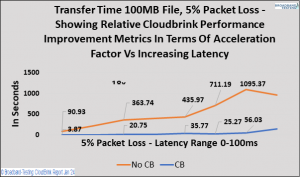New Optimisation Kid On The Block Puts Hybrid Users On The Cloudbrink Of Performance...
As many of you will know, one of my major focus areas since Stone Age Man (almost) has been network optimisation in its broadest sense.
It seems ironic that, in 2024, optimisation is required more than ever. Blame cloud, the pandemic, kids streaming their lives away… t’Interweb simply cannot cope with the massive daily increases of data, especially when a lot – or should I say – A LOT – of that is real-time date. I was asked, therefore, by US vendor Cloudbrink – itself somewhat youthful, though with series experience behind the scenes (being kind here in not using the term “industry veterans”) – to take a look at its Hybrid Access as a Service (HAaaS) solution. The full report is available here:
https://cloudbrink.com/broadband-performance-tests/
But to whet your appetite, sufficient to say that Cloudbrink’s own – via a 3rd party customer – observations of 30x acceleration, were smashed to eSmithereens in our own testing, where we saw up to 59x improvements – and that’s all within a fully secured network. What’s that about security versus performance trade-offs?

So, get that report downloaded, but to whet that appetite even further, here’s the Exec Summary from the report; happy remote accelerations… (maybe there’ll even be a Global Remote Acceleration Day in the world calendar shortly?):
Executive Summary
- The ever increasingly complex IT landscape has reinvented the need for new forms of network optimisation, security and management. Contemporary hybrid networks have effectively superseded the existing tools that were designed for a different kind of network topology and deployment.
- From an optimisation perspective, even if we argue that – over the past two decades – uptake of such technology has been underwhelming (after all, who wouldn’t want to optimise their application and data delivery?). there can be no argument now. Hybrid cloud/private networks mean more locations, more routes, more nodes and – therefore – more latency issues. Factor in the enormous increase in real-time traffic (especially video) as a result of the pandemic and that whole WFH/WFA (Work From Home/Anywhere) initiative, commonly called the “new norm” and those latency issues become greater than ever.
- The performance issues are further highlighted by the modern – and now almost de facto – method of delivering everything: software applications, platforms, unified comms and all – as a service. The lack of proximity to the closest delivery point (such as a PoP – Point of Presence) for many of these XaaS providers creates further latency and general performance issues, especially in areas of the world which are less well covered by the broadband and mobile operators.
- Those same hybrid networks have also created a significant security management question – how does an incumbent edge and centralised security infrastructure protect a hybrid network, where locations are not only both private and public, but where those public locations also vary – and without visibility? Hence there has been much talk of Zero Trust Network Architecture (ZTNA) and many offerings by many vendors, but the reality is that not all ZTNAs are equal.
- Cloudbrink – whose technology is the focus of this report – is looking to resolve all of the above problem areas with its take on delivering a software-based network architecture that meets the needs of the next generation of IT, both optimising performance and securing those connections.
- From a security perspective, at the heart of a ZTNA is primarily TLS (Transport Layer Security) which has seen various updates, with v1.2 having been widely adopted. However, some fundamental flaws in TLS 1.2 resulted in the release of 1.3 to resolve those issues. Cloudbrink is keen to stress that its adoption of TSL 1.3 is total – throughout its architecture, in every link of its communications chain – rather than a partial adoption, which can actually create more security issues than it fixes. It is also completely in line with Gartner’s AMTD (Automated Moving Target Defence) definition enabling security teams to constantly change the attack surface, making it harder for attackers to identify and exploit vulnerabilities.
- From a performance perspective, Cloudbrink claims up to a 30x performance improvement, but we found in a number of scenarios that this figure could be readily – and hugely in some instances – exceeded, especially when network conditions (latency, packet loss etc) become more challenging. Using a combination of different transfer file sizes and varying rates of both packet loss and latency, that at every data point, the Cloudbrink solution increased throughput and reduced transfer time, even in perfect network conditions.
- Note, this is in a fully secured test environment too; in past tests using VPNs, for example, we have seen up to 50% performance loss, simply because of the secure tunnelling of the connection. In Cloudbrinks’ case, this is a complete ZTNA delivery model but performance was hugely accelerated, regardless.
- Overall, Cloudbrink has created a network delivery architecture that seems tailor-made for the contemporary hybrid networks and “everything as a service” IT world we now inhabit. It is designed to secure and accelerate performance of the user connection, wherever they might be, yet is all defined, supported and controlled from a single point of management, itself available from anywhere.



